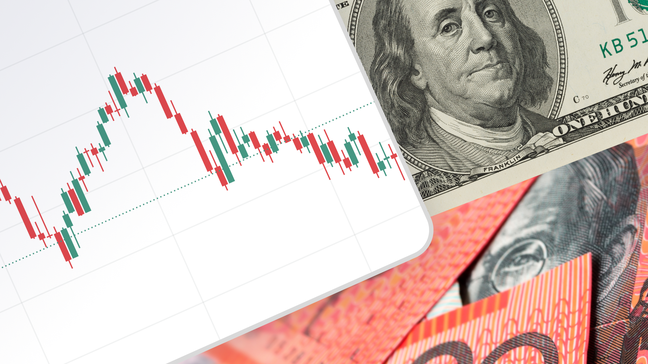Risk complex fades the previous day’s optimism as mostly downbeat data from the Asia-Pacific region join consolidation ahead of this week’s top-tier data/events from the Eurozone and the US.
With this, the US Dollar picks up bids to reverse the week-start losses but lacks upside momentum amid unimpressive second-tier data. That said, commodities and the US Treasury bond yields remain pressured while equities edge higher.
EURUSD and GBPUSD pause the recent advances whereas USDJPY resumes upside toward the 34-year high, after reversing from the same the previous day.
On the same line, AUDUSD and NZDUSD print losses whereas USDCAD bounces off a three-week low.
Talking about crypto, ETHUSD stays pressured for the second consecutive day on news that the US SEC has been examining Ethereum’s security status since March 2023. Further, BTCUSD reverses the week-start rebound from the lowest level in a fortnight even as BTC, and ETH ETFs debut in Hong Kong.
Following are the latest moves of the key assets:
- Brent oil remains pressured for the second consecutive day, down 0.30% intraday near $87.80 by the press time.
- Gold prints the biggest intraday loss in a week around $2,320 at the latest.
- The USD Index picks up bids to reverse the week-start losses near 105.95 as we write.
- Wall Street closed with minor gains while the Asia-Pacific shares edged higher. Further, European and UK shares trade mixed during the initial trading hour.
- BTCUSD and ETHUSD post intraday losses to around $63,300 and $3,170 at the latest.
The US Dollar licks its wounds…
The US Dollar began the week on a back foot amid a downbeat print of the second-tier activity data and cautious optimism ahead of this week’s top-tier catalysts. Also exerting downside pressure on the USD was a pullback in the US Treasury bond yields amid fears of witnessing a disappointment from this week’s FOMC and the US employment data, mainly because of the high hopes from the data/events. On Monday, the US Dallas Fed Manufacturing Business Index dropped to a three-month low of -14.5 versus the previous release of -14.4.
Apart from the aforementioned catalysts, an easing in the geopolitical woes from the Middle East also weighed on the Greenback and joined the upbeat US earnings season to propel the Wall Street benchmarks. However, prices of gold failed to cheer the US Dollar’s weakness on mixed concerns about Asian economies, the world’s biggest gold customers. In the same way, the easing of energy supply crunch fears and likely softening in the Oil demand from Asia exerted downside pressure on crude oil prices. It should be noted that the news suggesting the US easing some sanctions on Russian banks for Oil deals also weighed on the crude oil prices.
Earlier in the day, Japan released a slew of economic data but failed to extend the previous day’s retreat from a 34-year high amid mixed outcomes. That said, Japan’s Retail Trade eased, the Unemployment Rate stayed unchanged and the Industrial Production improved on MoM but slumped on YoY for March. It’s worth noting that the nation’s top currency diplomat Masato Kanda cited a need to take appropriate actions on FX but couldn’t tame the Yen’s downside. Furthermore, the International Monetary Fund (IMF) saw Japanese authorities fully committed to a flexible exchange rate regime while adding, “Yen depreciation reflects interest rate differentials, other factors.”
The IMF also stated that the Asia-Pacific economies are headed for a 'soft landing' while citing slower economic growth in China, from 5.2% for 2023 to 4.6% for 2024 and 4.1% in 2025. In addition to the IMF comments, a mixed bag of activity data from Beijing also played their roles in reversing the week-start optimism and underpinned the US Dollar’s rebound. Talking about the data, China’s official Manufacturing gauge, namely the NBS Manufacturing PMI for April eased to 50.4 from 50.8, versus 50.3 expected, whereas the Caixin counterpart rose to 51.4 compared to the market forecast of 51.0 and 51.1 prior. Further, the NBS Non-Manufacturing PMI for the said month also dropped to 51.2 versus the analysts’ consensus of 52.2 and the previous release of 53.0.
Downbeat China PMIs joined the disappointing growth of Australia’s Retail Sales in March, from 0.2% to -0.4% MoM, to weigh on the AUDUSD price, making the Australian Dollar (AUD) the biggest loser among the G10 currencies. On the same line, New Zealand’s ANZ Business Confidence for April eased to 14.9% from 22.9% and the Activity Outlook also weakened to 14.3% from 22.5%, which in turn joined disappointing catalysts from China and Australia to weigh on the NZDUSD pair.
Elsewhere, the UK’s shop prices, per the British Retail Consortium (BRC) Shop Price Index, marked slower growth since December 2021 by reporting a 0.8% YoY increase for April versus 1.3% prior. Also notable was a deterioration in the prices for non-food goods, -0.6% YoY, the first negative reading since October 2021. The same joins the US Dollar’s corrective bounce to drag the GBPUSD pair from a two-week high.
EURUSD also reverses the week-start gains amid an overall recovery in the US Dollar and a cautious mood ahead of today’s preliminary readings of the Eurozone Q1 GDP and the first prints of the top-tier inflation data for April. Also exerting downside pressure on the Euro could be the previous day’s softer German inflation data and dovish comments from the European Central Bank (ECB) officials. On Monday, ECB Vice President Luis de Guindos said that they are (ECB) heading in the right direction on inflation. On the same line, ECB policymaker and Head of the Dutch Central Bank Klaas Knot said that he is increasingly confident about falling inflation while adding, “June rate cut realistic.”
- Strong buy: USDCAD, USDJPY, US Dollar
- Strong sell: AUDUSD, NZDUSD, GBPUSD
- Buy: BTCUSD, ETHUSD, Nasdaq, Gold
- Sell: DAX, FTSE 100, BTCUSD, EURUSD
German, EU calendar in focus…
A slew of top-tier data from Germany and the Eurozone will entertain momentum traders after a sluggish start of the week. Also important will be the second-tier statistics from the US.
That said, the first readings of the Q1 2024 GDP from Germany and the EU will join the flash prints of the Eurozone inflation data for April to highlight EURUSD as today’s key pair. Given the growing concerns about a “soft landing” in the bloc, as well as the dovish ECB bias, the Euro pair is likely to witness further downside unless the scheduled data provide a positive surprise, which is less expected.
On a different page, the Chicago Purchasing Managers’ Index for April, the Housing Price Index for February, and S&P/Case-Shiller Home Price Indices for the said month will also contribute to the market’s liquidity. That said, the US data are less likely to gain major attention ahead of Wednesday’s FOMC.
May the trading luck be with you!




